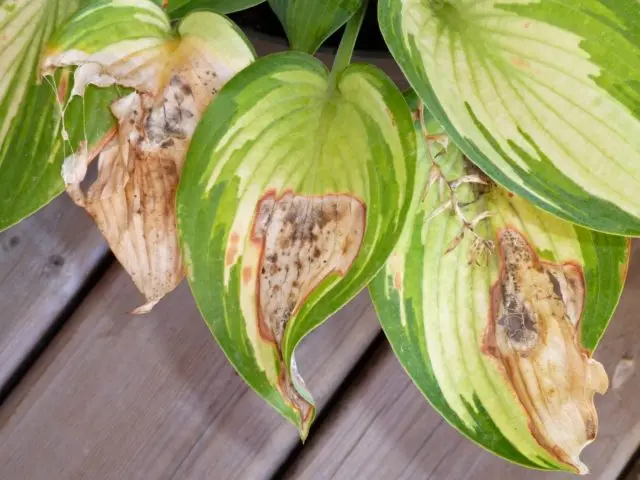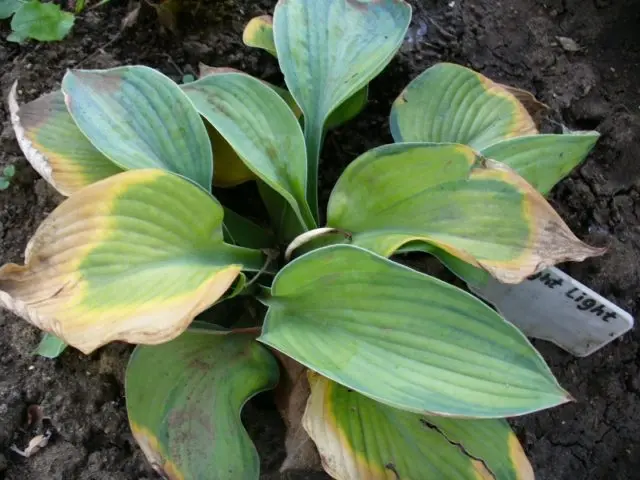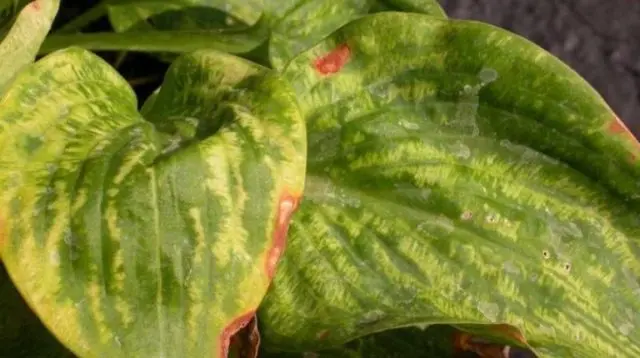Contents
Most horticultural crops need enough sunlight and react painfully to its lack. However, there are those among them for whom a shadow is a necessary condition for good development. These include giant hostas – shade-tolerant ornamental plants that many gardeners use for planting in those parts of the garden where the rays of the sun rarely look.
Benefits of Growing Large Hosta Varieties
Giant hostas will appeal to all lovers of large plants. Despite the fact that these are herbaceous plants, their size is impressive. The height of the host can reach 1,5 m, while in the circumference the bush can reach a diameter of 2 m or even more.
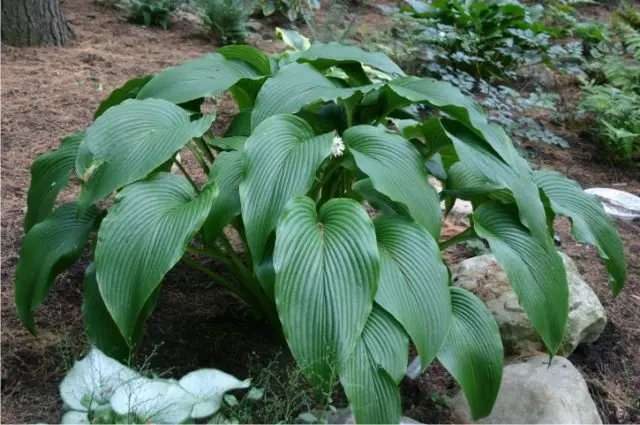
Giant flower beds look great in group plantings
Growing such giant plants has several advantages:
- Each giant hosta covers a large area. Therefore, a small amount of planting material is required to fill the required area.
- Giant hostas are unpretentious and grow well in shady places unsuitable for most garden plants. This allows you to increase the decorativeness of the garden as a whole and its individual corners in particular.
- For normal development, giants need very little: shade, fertile land and an abundance of moisture.
- A large number of types of colors and sizes allows the use of giant hostas in various landscape compositions.
- Plants are perennials, in one place they can grow up to 10, and sometimes up to 20 years.
- Giant hostas have good frost resistance and even in the middle lane do not freeze out in winter without shelter.
Another advantage of growing these plants is the ease of breeding. Giant hostas reproduce well both by seeds and vegetatively.
The best types and varieties of large hosts
Types of giant hostas differ not only in size, but also in the shape and color of the leaves, the way they are colored, shades, and shade tolerance. This makes it possible to finely select plants for the design of each specific site in accordance with the requirements of the existing landscape and the desire of the designer.
Jade Cascade
Hosta Jade Cascade lives up to its name. In appearance, it is a flowing fountain of large drooping green-olive leaves growing on long petioles. It can reach a height of 1,1 m, the circumference of the bush is 1,5 m. The leaves of Jade Cascade are large, oval, with a wavy edge and a sharp tip, with deep longitudinal veins, perfectly readable on the leaf plate. The inflorescences are a panicle of lavender bell-shaped flowers with an elongated corolla, growing on a long peduncle.
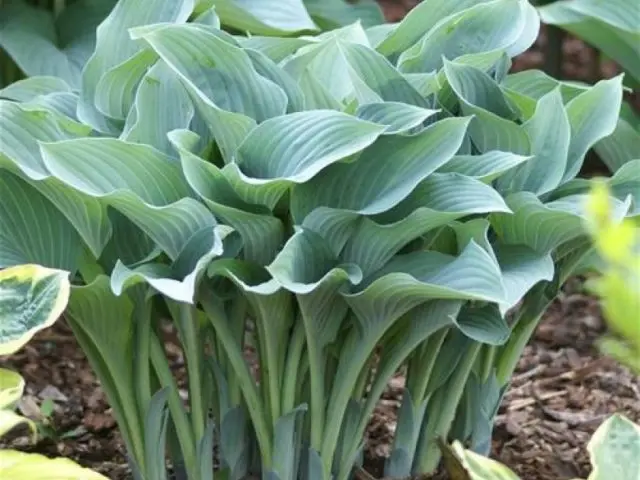
Jane Cascade looks like a fountain
Elegance
Very interesting large Hosta Elegans growing up to 0,7 m in height. A distinctive feature of this plant is the specific relief surface of the leaf plate, which increases markedly as the bush grows older.
Leaves are bluish in shade and turn green in sun. The plate has the shape of a heart, slightly bent like a boat, the edges are tucked up slightly. Peduncles slightly go beyond the size of the bush. The flowers are white, with a slight lilac tint, appear relatively early in June compared to other species.

elegans leaves have a bumpy embossed surface
Cross Regal
The large vase-shaped hosta Krossa Regal grows up to 0,7-0,9 m, and with the appearance of peduncles, its height can increase to 1,2 m. The bush can eventually grow up to 1,5 m in diameter. Petioles are light, almost vertical, massive, dense. The plate has an elongated pointed tip, slightly twisted. The leaves of the hosta Crossa Regal are light green, with a bluish tint, deep longitudinal veins are well read on them. Flowers with a purple tint, collected in paniculate inflorescences.

Vase-shaped bush of Crossa Regal can grow strongly in breadth
Empress Wu
The giant hosta Empress Wu, or Empress Wu, is considered the highest in the world. With good care, its growth can reach up to 1,5 m, and the diameter of the bush can be up to 2,5 m. Under the leaves of this plant, a person of small stature may well hide from the rain. The leaf plate is dense, saturated green in color, with clear deep veins. The length and width is a little less than 0,5 m, and in some cases this figure can reach up to 0,7 m.
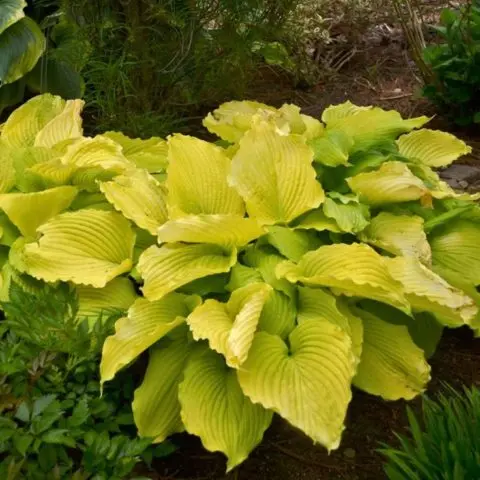
Empress Wu is considered the tallest in the world.
This giant hosta blooms in July, with large flowers with an elongated, light purple corolla. For normal growth, it requires a shady or semi-shady area with moist, fertile soil.
Francis Williams
This giant hosta received its modern name quite recently, in 1970. Until that time, it was attributed to the elegans variety and was not distinguished as a separate species. In height, the giant hosta Frances Williams grows 0,65-0,7 m. Its distinguishing feature is the leaves of a bluish tint with a yellow border around the edge. The sheet plate is corrugated, bubble structure. The flowers are white, with an elongated corolla, quite large. The flowering period is July.
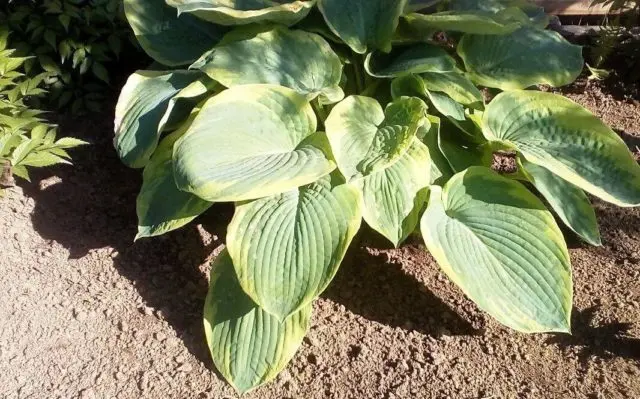
The wide yellow border on the leaves gives Francis Williams a special decorative effect.
Ice Hello
Hosta Aisi Halo grows in height up to 0,9 m, while in breadth it is heard much stronger, the diameter of the bush can reach up to 1,8-1,9 m. The variety has large, pointed green leaves with a grayish tinge, bordered along the edge with a thin light stripe. Flowering occurs in July. Flowers Icy Halo lavender shade, large, collected in paniculate inflorescences.
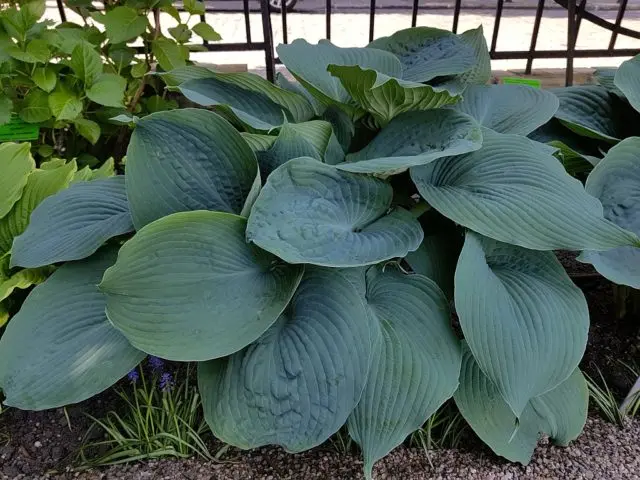
Icy Halo leaves are heart shaped
Montana
The giant hosta Montana is one of the largest. Its second name is Mountain. The leaves are heart-shaped, with a pointed end, green. The veins are very clearly read on the plate, forming a beautiful relief pattern.
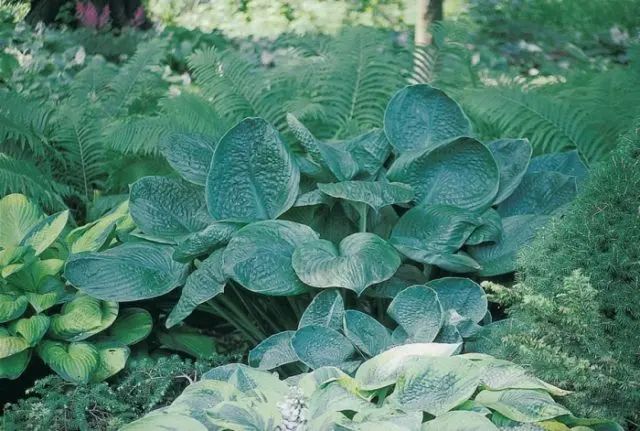
Deep veins on Montana leaves form a clear relief
Liberty
The giant hosta Liberty has a full bicolor leaf color. Their outer part is yellow, golden or creamy, the inner one is bright green. The bush is distinguished by its solid size, it can reach a height of 1 m, and grow up to 1,7-1,8 m in circumference. In July, flower stalks appear, on which large light, funnel-shaped flowers bloom with lavender-colored petals.
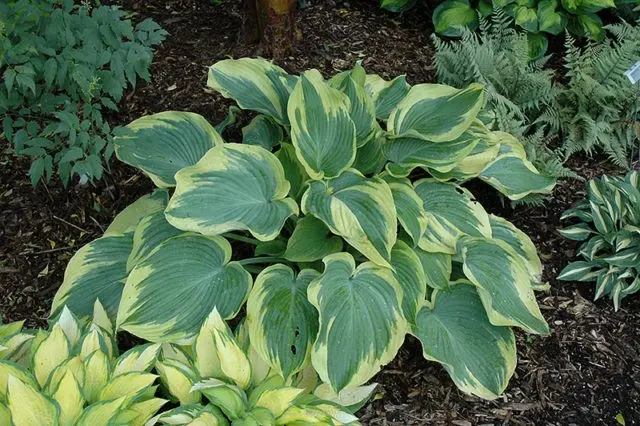
Liberty has a two-tone color
Coast to Coast
The variety of giant hosta Coast to coast has a characteristic yellow-green color. The leaf plate has clearly visible, slightly depressed veins, giving a special relief. The edge of the leaf is wavy, the tip is elongated-pointed. The average height of the bush is 0,7-0,8 m, the circumference of the crown is 1,2 m. Lavender-colored flowers appear in July.
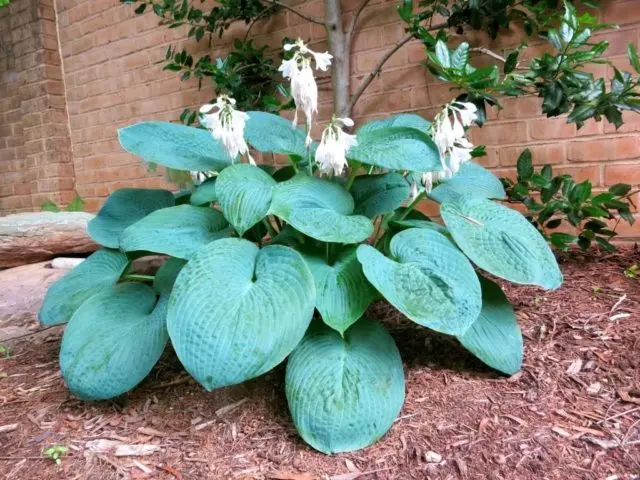
Coast to Coast – a variety with unusual light green-yellow leaves with a wavy edge
Montata Aureomarginata
A rather large hosta Montana Aureomarginata is vase-shaped, the height of which reaches 0,6-0,7 m. It is distinguished by the rich green color of the leaf plates with a characteristic light yellow border. Over time, the color of the edge of the peripheral areas changes to milky, while the central young leaves do not change it.
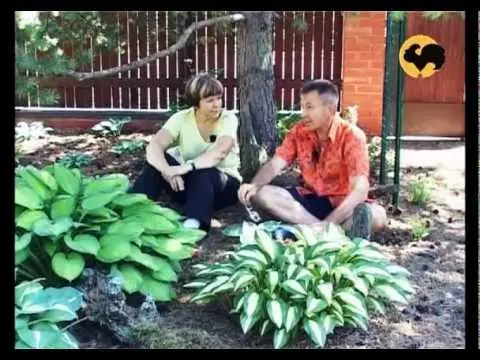
Montana aureomarginata forms a vase-shaped shrub
The leaf plate of the hosta Montana Aureomarginata is heart-shaped, the pointed ends are slightly drooping. Peduncles straight, not very thick. Flowers white, few.
Dino
Hosta Dino can grow up to 1,2 m under good conditions, while growing in width to almost 2 m. The leaves are rounded-elongated, with a sharp tip and well-read veins.
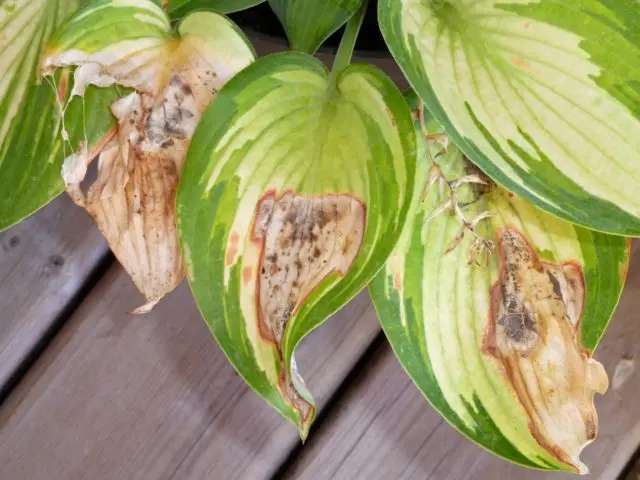
Dino can grow a lot in breadth over time
Along the edge of the leaf plate there is a blurred light strip of yellow or milky color. Blooms in mid-summer.
Sagahe
The giant hosta Sagae grows into a vase-shaped bush, the height of which can reach up to 0,75 m, and the circumference – up to 1,75 m. The leaves are green, with a bluish tint in the center and a light border along the edge, broadly ovate with a heart-shaped base. The plate is dense, even hard to the touch.
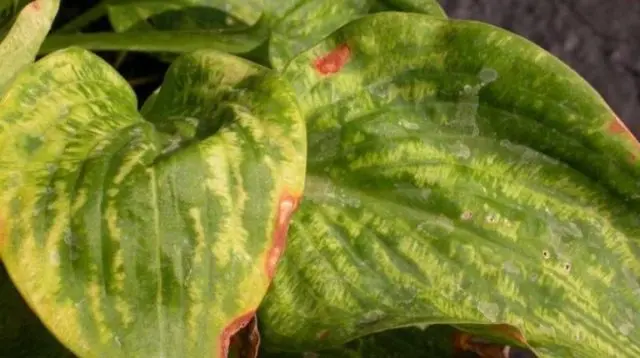
The leader of the rating of the American Association of Host Fanciers is the variety Sagae
Peduncles can grow up to a height of 1,25 m. Hosta Sagae blooms in July-August, the petals of large funnel-shaped flowers have a pale lavender hue.
Blue Mammoth
Blue Mammonth owes its name to its large size and bluish color. The domed bush can grow up to 0,9 m in height and 1,65 m in diameter. The leaves are large, broadly ovate, in the center the color has a blue tint, later it becomes bright green. The sheet plate is dense, the veins are clearly read, creating a convex relief. Funnel-shaped flowers, large, almost white, appear on peduncles in July.

Blue Mammoth gets its name from its huge leaves and bluish coloration.
You Rex
The height of the T-rex hosta bush can reach up to 0,7 m, while the plant grows strongly in breadth, up to 1,8 m. The leaves are bright green, very large, with a wavy edge, oval-elongated, heart-shaped structure. Venation is strong. Peduncles grow up to 0,9 m, flowering time – July. Flowers large, white.
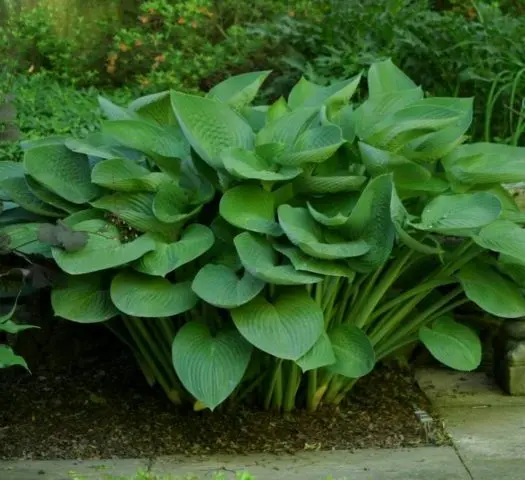
T Rex grows up to 0,7 m
Blu Umbrellaz
The giant hosta Blue Umbrellas grows rather weakly in breadth. With a bush height of about 1 m, its circumference usually does not exceed 1,2 m. The leaves are large, with good venation and a clear relief. The color is bluish, turning green towards the end of the season. Flower stalks appear in July-August. The flowers are large, bluish or lilac, funnel-shaped.
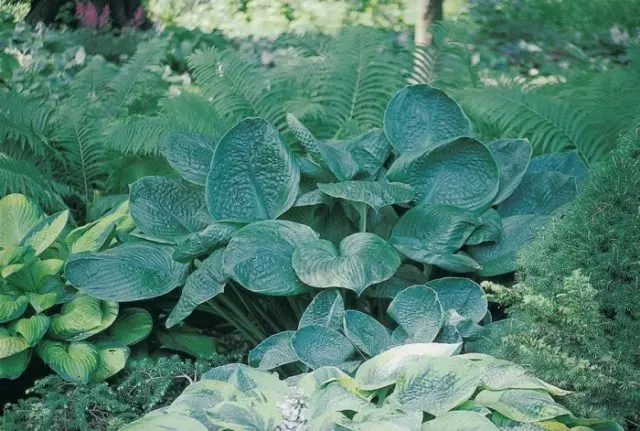
The bluish leaf plate of Blue Ambrellas is heavily corrugated
Sam & Substens
This is one of the varieties of tall hostas with a yellow color. The domed bush Sum and Substance can grow up to 0,9 m, while its circumference reaches 1,75 m. The leaves are dense, with deep veins, green at the base, becoming more and more yellow towards the end. It blooms in July-August with large, pale lavender flowers.

Sam and Substens – a hosta with a yellow color that intensifies in the sun
Angel
The blue-green leaves with a wide creamy-gold border are a real eye-catcher for this giant hosta. Visually, the bush looks very impressive, in the rating of the US Host Association for 2009, this variety confidently took 1st place. The height of an adult plant is about 0,8 m, the circumference is about 1,5 m. Earth Angel blooms in June-July. The flowers are white, lavender or pale purple, large, funnel-shaped or bell-shaped.
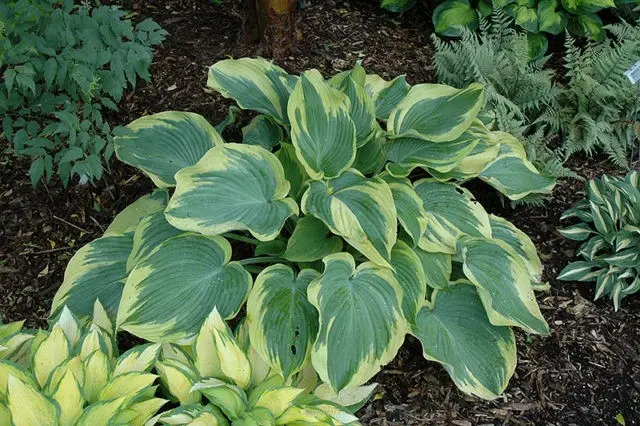
Spectacular Es Angel bushes will not leave anyone indifferent
Niagara Falls
An adult bush of this giant hosta can reach a height of 0,9 m, while growing up to 1,7 m wide. A distinctive feature of the Niagara Falls variety is convex bright green leaves with deep venation and a wavy embossed edge, which gives the plant a special decorative effect. Peduncles grow up to 1,2 m. Flowering occurs in July, the buds are light, purple or lilac, bell-shaped.
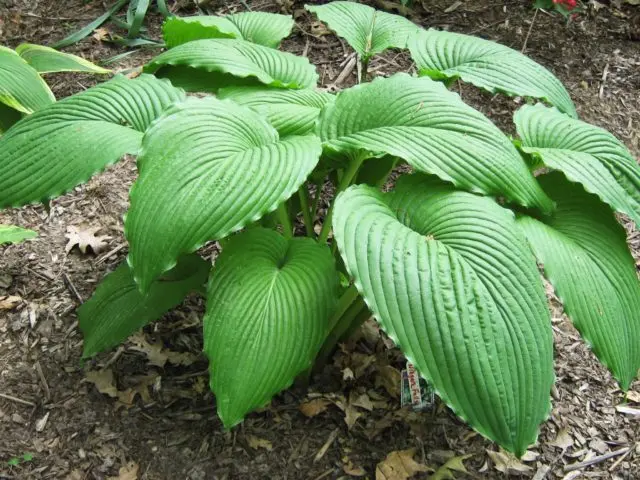
Niagara Falls looks like a dome
Big Daddy
Hosta of this variety forms a large domed shrub about 0,6 m high and about 1 m in diameter. The leaves are cup-shaped, dark at the beginning of the season, with a blue tint and a persistent light chalky bloom, later turning green. The plate of Big Daddy is heavily corrugated, especially in adult specimens. Peduncles grow up to 1,2 m, in July-August large light flowers of a white-bluish color appear, collected in tassels.
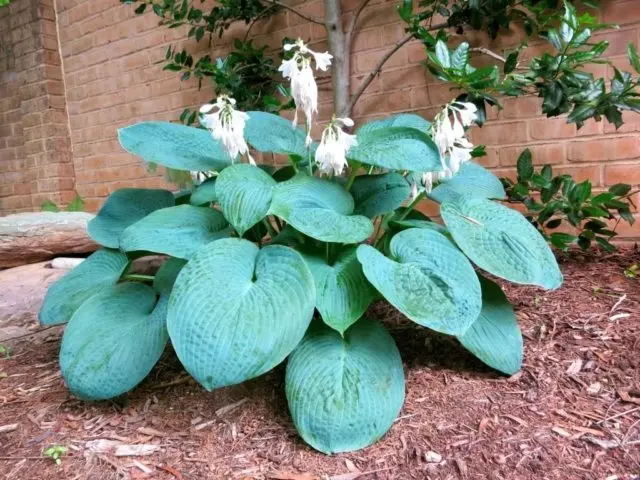
Young leaves of Big Daddy are covered with chalk.
Giant hostas in landscape design
Giant hostas are versatile plants and can be used in a wide variety of garden compositions. They are planted solo and in groups in flower beds, they decorate paths, banks of artificial reservoirs, ponds. The massive greenery of the hosta is often used as a backdrop for flowers. In shady corners, they are used as ground cover plants. Giant hostas are used to decorate the garden in the English, French and Japanese style, they are planted at the foot of vertical supports, on architectural objects.
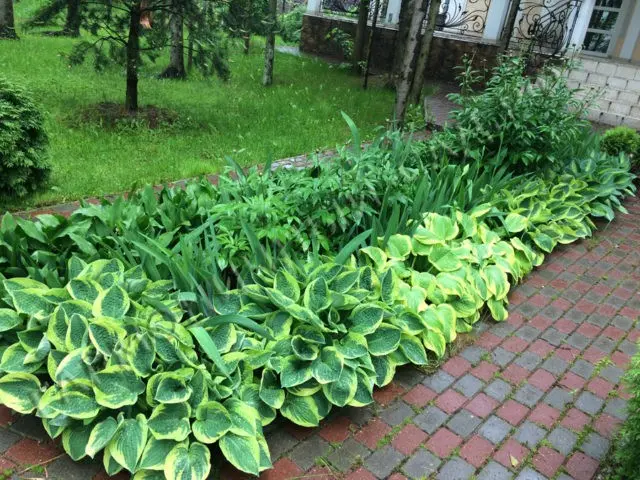
Often hostas are planted as border plants.
Peculiarities of growing
Giant hostas are planted, as a rule, in shaded and semi-shaded areas of the garden, in those places where the sun appears for a limited amount of time during the day. There are no special requirements for the composition of the soil, although fertile loams are best suited for planting this plant. Poor soils must first be fed with humus and fertilized.
Hostas do not require increased care during the season. They only need to be watered regularly, take care of the root zone, and loosen the soil. Of great importance is the mulching of the surface with organic matter. It is the mulch that is the main source of nutrients for the host, especially if the plant is planted next to a large tree. They are usually fed with organic matter and complex mineral fertilizers, at the beginning of the growing season and at the end of flowering.
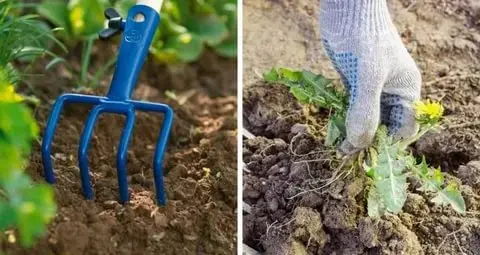
Hostas require regular maintenance of the root zone.
Giant hostas do not require shelter for the winter. Cut or not cut the leaves before wintering – the gardener decides. There is no consensus on this issue. Some consider the dying aerial part as additional protection from the cold, others see them as a source of possible diseases and pests. In any case, the root zone after the onset of winter must be insulated with a layer of snow. This is quite enough, since high frost resistance allows you to endure winter cold without any additional shelter in most regions of Our Country.
Diseases and pests
Giant hosts rarely get sick, but weakened plants sometimes develop fungal infections. The most common diseases of these plants:
- Phyllostictosis, or brown spotting. You can recognize the disease by brown-brown spots on the leaves. The infected parts of the plant must be cut and burned, and the hosts themselves should be treated with Abiga-Peak or Strobi preparations. With a strong defeat, it is necessary to dig up and destroy the entire plant. Since the causative agent of the fungus lives in the soil, the soil must be disinfected with formalin.

Brown spots on the leaves may indicate hosta phyllosticosis.
- gray rot, or botrytis. It is detected by ashy bloom or rotting of the tips of the leaves, which gradually spreads to the entire leaf plate. Sick shoots are cut out and burned, and the plants are treated with Kuproskat or Topaz.

Gray rot usually begins to develop from the edge of the leaf.
- Rust. Most often, the manifestation of the disease can be seen along the edges of the leaf plate in varieties with a colored yellow border. It is the result of insufficient watering or improper planting. In the affected plant, the metabolism is disturbed, it gradually dries out. There are no treatments. Prevention is timely watering and the right choice of landing site.

Rust occurs due to water imbalance.
Of the pests, the greatest danger to hosts is slugs, which actively eat the green mass of the plant. A sign of their appearance are numerous rounded holes in the leaves. To combat these invertebrates, various traps are used, mollusks are collected by hand, loose materials are poured around the host, which prevent gastropod pests from moving.
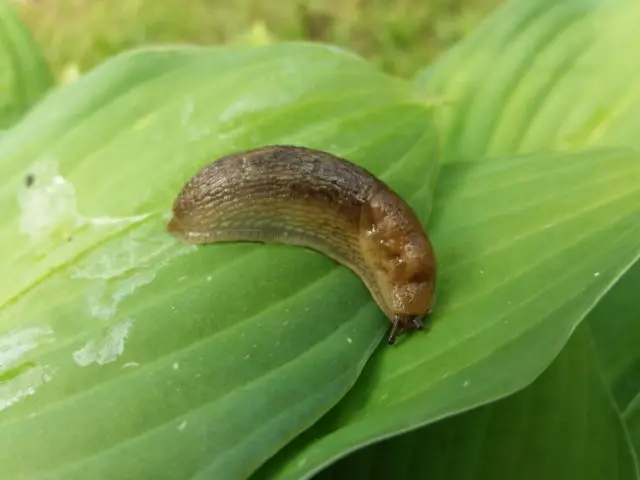
Slugs are the most terrible enemies of hosts.
With large numbers of slugs, you can use chemicals such as Thunderstorm or Thunder, as well as biological products, for example, Ulitsid.
Conclusion
Giant hostas are excellent decorative perennials that are widely used in landscape design. They do not require increased care, reproduce easily and feel great in places where other plants do not develop well – in the shade and partial shade. There are several hundred types and varieties of hostas of various shapes and colors, so choosing the most suitable one will not be difficult.










